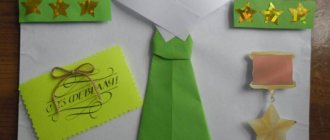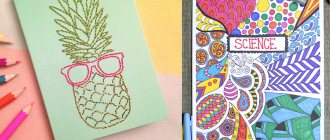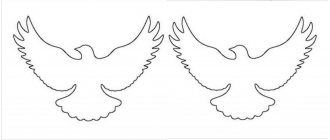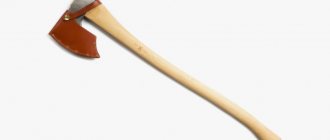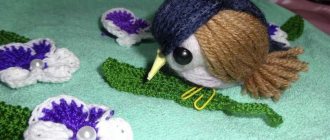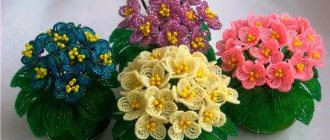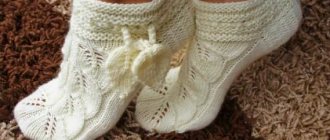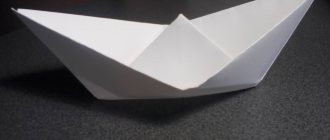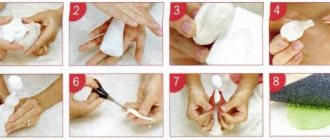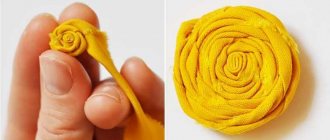Home House and cottage Do it yourself
A newspaper cap is a cute and practical headdress that protects from the sun's rays. The biggest advantage of such a hat is that it can be made in a few minutes anywhere. To do this, you don’t need scissors, glue, or threads—it’s enough to know how to properly roll an ordinary newspaper. It is believed that it is correct to wear a classic cap slightly tilted to one side. Often this does not work out, since it is not always possible to choose the correct size of this headdress. There are no such problems with a paper cap; its main purpose is protection from the sun. In addition, a paper cap can be made very original. It is believed that a classic cap is a small cap, flattened on the left and right. But now a cap can be called an ordinary sun hat from a newspaper. All you have to do is use your imagination and from a sheet of newspaper you will get a cap in the style of a cowboy hat or cap with a visor. After all, modern designers on high fashion catwalks have been experimenting with this model of cap for a long time, why don’t we try to make something special out of the classic version of a military headdress?
So, to make a cap we need a spread of a regular newspaper. Some models of caps use a ruler, pencil and paper clips, but this is not at all necessary. We will be putting together the following cap options:
- Classic cap
- Pioneer cap
- Budenovka pilot's cap
- Square cap
- Cap with visor
- Aviation pilot
- Rain helmet
- Ordinary cap
- Medical cap
- Chef cap
- Nurse cap
- Cap
- African cap
- Square cap
- Cowboy hat
- Cap-Chinese cap
- Elegant cap
- Simple cap
- Santa cap
Classic newspaper cap
A classic version of a neat cap, worn slightly to the side.
To make a cap, it is better to take a square from a newspaper with a side equal to the volume of the head plus 1.5-2 cm.
- Fold the newspaper in half.
- We bend each of the resulting rectangles in half to the center.
- Then we fold part of the paper from the edge of the newspaper to the resulting fold line again.
- We bend the upper corners into a triangle into the center of the model. We lift up the bent part of the newspaper from the edge.
- Turn it over to the other side and bend it left and right along the fold lines. The result was a square with folds.
- The bottom edge needs to be folded over the folds, then straightened.
- Decorate as you wish with stickers.
How to beautifully design a military cap made of paper with your own hands
A paper military cap is an excellent alternative to a fabric product. Its production will not take much time. Below is a diagram for creating a military cap from paper.
Once the base is ready, you need to start decorating. To decorate a soldier's cap made of paper, you will need the following materials and tools:
- brush;
- glass of water;
- green paint;
- scissors;
- sheet;
- pencil;
- ruler;
- red paint;
- glue.
The paper base is painted green and left to dry. On a blank sheet of paper, using a ruler, you need to draw a star and paint it over with red paint. When the sheet dries, the drawn element is cut out along the contour and then glued to the green base.
Important! Watercolors are not suitable for painting. The sheet will get wet and tear at the folds. The right solution would be to use gouache in your work.
In addition, a product with a voluminous star will look interesting. It can be done using the origami technique, the art of folding different shapes, or by gluing a printed template. To create the simplest star you will need red paper, scissors and glue. Manufacturing instructions:
- A strip is cut from red paper.
- Next, the tape is folded into a knot and the edges are smoothed.
- The upper end is hidden in the resulting pocket.
- The workpiece is turned over, and the remaining edge is glued to the base. The excess is cut off.
- Once the glue has dried, you can begin to form the star.
- All edges are pressed to create a clear outline of the corners.
Step-by-step plan for creating a star using the second method:
- Lines are drawn on the sheet as shown below. After which the base is cut along the contour.
- A cone is formed from the resulting triangle by gluing the side part. You will need 5 such blanks.
- Next, you need to fasten all the elements together and paint the finished product red.
Advice! Material that is too thin, such as papyrus or colored sheets, is not suitable for making a cap. When bent, they will quickly wrinkle, and after painting they will get wet.
Pioneer cap
A cap of a slightly modified shape that can be worn not only on the side, but also in the middle of the head.
- Fold the newspaper spread in half and fold it over to mark the center line.
- We bend the corners of the center line towards the center of the model.
- We bend one layer from the bottom up and up again.
- Turn it over. We bend one side on the side about halfway, then the other too. We bend the bottom edge of the model along the bottom edge of the rim.
- We unfold the cap and bend the small corners from below to the intended line.
- We fold the paper up again, then up again.
- We turn the model over. We first bend the large corner down and then hide it.
What kind of paper hats can be made using glue?
In addition to origami hats, there are many models of paper hats, the manufacture of which will require additional glue, scissors and a pencil. These hats take a little longer to make, but the result will not disappoint.
Fun top hats, paper caps or cowboy hats can be worn to a children's party, New Year's party or just to create a good mood.
Paper cylinder
The young gentleman will definitely love the paper cylinder.
To make it you will need a sheet of colored paper. You can take the packaging. And also a thick paper or cardboard sheet of A4 format, scissors, glue, paints, a pencil, two circles of different diameters.
After preparing everything you need, you can start working:
- Cut a strip from a colored sheet. The width of the strip is the height of the future hat, the length is equal to the circumference of the cylinder.
- Roll the strip into a pipe and glue it together.
- On a sheet of cardboard, draw two circles of different diameters with a common center. The inner circle should be equal in diameter to the glued pipe. The difference between them is the width of the cylinder fields.
- Color the resulting fields and cut them out.
- Cut the bottom edge of the pipe into a fringe 1 cm deep and wide.
At this stage, all the parts are ready, all that remains is to connect them. To do this, you need to bend the fringe of the pipe outward, put the cut ring on the pipe and glue the fringe along its lower side.
You can diversify the hat with additional fun decor.
Paper cap
Both boys and girls will like this paper cap.
The girlish version can be decorated with artificial flowers or appliqués.
In addition to decorative elements, to make a baseball cap you will need:
The cap is made as follows:
- Prepare a pattern for 6 or 8 sections of the desired size. Transfer the details onto paper material.
- Cut out the main part of the hat.
- Use a hole punch to make one hole in the corners of the sections.
- Align the holes.
- Insert a rivet into all holes.
- Secure it by spreading the legs in different directions.
- Glue the tail to the side.
- Cut out the visor part.
- Bend its fringe.
- Spread with glue.
- Glue to the inside of the main part of the cap.
And now the baseball cap is ready. You can move on to decorating it.
Budenovka pilot's cap
A functional cap model that is very convenient for sun protection.
- Fold the newspaper spread in half, then fold it in half on the other side to mark the center fold line.
- We unfold and along this line we bend the corners on one side and the other.
- We bend the rim from below, turn it over to the other side and also bend the rim.
- We bend the corners at the bottom to the opposite side. This results in an isosceles triangle.
- We unfold the model along the side fold line so that the cut shape takes the form of a square.
- We bend the corners from the bottom towards the center of the model. The pilot is ready.
Making hats
When hiking, on the beach, or working in the field, paper hats are an excellent means of protection from the sun. They are usually made from newspaper. For school performances, hats can be made from thick drawing, drawing, or table paper with further coloring or finishing of the resulting product.
Cap.
The craft is made from half a large format newspaper sheet.
The paper is placed narrow side down. Take the upper right and left corners with both hands and fold them towards you so that the sides coincide (Fig. 8, a)
.
The fold lines are ironed well. Having divided the upper side into approximately three parts, bend the corners (Fig. 8, b)
.
Then take one of the bottom strips, divide it in half and fold it up twice, covering the corners. Iron the craft and turn the back side towards you (Fig. 8, c, d)
.
Fold the sides taking into account the size of the headdress (Fig. 8, d)
.
To get a smaller craft, fold the sides more. The remaining lower part is folded up twice and secured to the valves formed as a result of the previous operation (Fig. 8, e)
.
The craft is ready (Fig. 8, g)
.
Budenovka
.
The craft is made from green table paper. The sheet is placed in front of you with the smaller side down and the corners are bent from above so that they meet in the middle (Fig. 9, a, b)
.
The resulting angle is bent down (Fig. 9, c)
.
Having ironed the fold lines, turn the product back to you. Bend the corners again to the middle of the sheet (Fig. 9, d)
.
The remaining strip, divided in half, is folded up twice (Fig. 9, d)
. A red paper star is glued onto the finished product. The craft is ready (Fig. 9, f).
Papakha
.
The craft is made from thick paper. First, the paper is folded in half along the long side (Fig. 10, a, b)
.
Then the upper right double corner is bent so that it coincides with the bottom side, and the lower left - with the top (Fig. 10, c)
.
Then fold the entire craft in half along a line that runs parallel to the right and left sides. As a result of folding, these sides form a lower straight line, consisting of two parts superimposed on one another (Fig. 10, d)
.
Now the right acute corner is bent to the front side and secured at the left angle. The left corner is bent to the opposite side and secured in the same way (Fig. 10, e).
Having opened the craft, straighten the upper part of the hat
(Fig. 10, f)
.
Hood.
The craft is made from large format newspaper.
If you need a smaller hood, then it is made from half a sheet of newspaper. The paper is folded in half (Fig. 11, a)
and the corners on the uncut side are bent so that they meet on the midline
(Fig. 11, b)
.
The lower strips are bent on opposite sides (Fig. 11, c)
.
Then the craft is taken by the lower double sides with both hands and spread them apart so that a square is formed (Fig. 11, d)
.
The lower double corners are bent upward in opposite directions (Fig. 11.6)
.
The sides are separated again (Fig. 11, e)
.
Bend the acute angle upward. Give the craft the desired shape (Fig. 11, g)
.
Hat with visor.
The craft is made from large format newspaper.
Place a newspaper folded in half in front of you and bend the corners from the uncut side to the middle (Fig. 12, a, b)
.
The resulting angle, dividing the sides in half, is bent down, one of the two lower strips is folded with two bends up (Fig. 12, c)
and ironed well.
Turn the craft with the smooth side towards you (Fig. 12, d)
and fold the sides with two folds.
The size of the headdress depends on the size of the folds (Fig. 12, d)
.
Then fold the bottom strip in half, bend the corners and insert them into the slot (Fig. 12, e)
.
For the convenience of performing the next operation, the left hand is inserted into the craft, and the right hand bends the corners of the hat and secures them to the side stripes, finally forming the craft (Fig. 12, g)
.
G. I. Pereverten “Homemade paper” Moscow “Enlightenment” 1983
Square cap
An unusual version of the cap, which fits tightly to the head and has a visor.
- Fold the newspaper in half and then into a quarter to locate the center line.
- Open it up and make a triangular roof.
- First fold the rectangular strips into 2 halves, then bend them.
- Turn the model over and bend the edges from the sides towards the center of the model.
- Let's fold regular triangles in both corners.
- We bend the triangular roof and tuck it in.
- Open the model and align it to form a square.
- Rotating, bend the corners, open.
- We turn 4 corners. The result is a hat in the shape of a box.
When did Budenovka appear?
In 1918, a competition was announced to create a headdress for soldiers of the Red Army, in which the sketch of the “heroka” won. The cloth hero hat resembled the medieval “erikhonka” or a shelom with aventail.
Subsequently, this headdress was modified for winter uniforms and nicknamed “Budenovka” in honor of the division of Semyon Mikhailovich Budyonny. On the right in the photo is Budyonny himself in Budenovka. This is a very rare shot.
Cap with visor
- Fold the newspaper in half, then fold the other side in half to mark the center fold line.
- We unfold and along this line we bend the corners on one side and the other.
- We bend the rim from below, then turn it over to the other side and crimp the corners of the rim.
- On the left and right we fold the model to the center fold line.
- We fold the strip of paper from the bottom to the middle, bending it in half.
- Then we bend the corners of the rim towards the center of the model and tuck it into the middle.
- We turn the model over. We fold the largest upper corner towards the center of the model and tuck it under the rim.
- We unfold the model, pressing it a little in the center. The cap is almost ready, all that remains is to bend the corners at the top and hide them under the paper.
Model-based folding algorithm
When creating a paper or cardboard cap, you must carefully bend and smooth all the lines. Then the product will fit well on the head and hold its given shape perfectly. The finished headdress can be used for theatrical performances, games, and sun protection.
Quick from the newspaper
If you don’t have time to make complex models, you can quickly make a neat cap. A square-shaped newspaper is suitable for these purposes. Its side should be equal to the volume of the head with an allowance of 2 cm. Algorithm of actions:
- Fold the newspaper spread in half.
- You will get two rectangles that need to be bent towards the center.
- Fold part of the paper from edge to fold.
- Fold the top corners into a triangle shape towards the center.
- Lift the folded parts of the newspaper up from the edge.
- Turn the model over to the other side.
- Fold the pieces of newspaper on both sides along the fold line. You should end up with a square with folds.
- The lower border of the product should be folded over the paper folds and straightened.
Typically, this paper cap model is worn slightly to one side. You can decorate the product at your discretion, for example, paint it with paints or paste it with stickers.
For the cap, you can take two small newspapers. Newspapers are glued together with tape. Bend the right corner to the center line.
The right corner folds in the same way as the left
First bend the rectangular strip in half
Bend it again The cap hood is ready
Budenovka pilot's cap
This cap model is made from a newspaper spread. The product provides excellent protection from the sun. To make a paper budenovka, you will need to perform a number of steps:
- fold the paper in half;
- mark the fold line;
- unfold the corners on both sides, bend them;
- fold the rim from below;
- turn the product over to the opposite side;
- bend the rim;
- bend the lower corners to the other side, you should get an isosceles triangle;
- unfold the model along the fold line;
- bend the corners towards the center of the product.
A stronger cap will be obtained from the spread of a glossy magazine, but bending such a sheet will be more difficult than a newspaper sheet.
Medical
The medical cap pattern allows you to make a headdress for a masquerade or theme party. You will need a rectangular paper sheet. Procedure:
- you should take a sheet and fold it in half;
- fold a strip of paper along the bottom, 1.5 cm from the edge;
- turn both halves to the fold line with a triangle;
- turn the product over to the other side;
- unscrew the top edge of the model;
- fold the bottom edge lengthwise;
- Pressing from above, open the product, bending three folds upward.
The finished medical cap should be painted white, and a red cross should be drawn in the center of the product. It is more rational to use a sheet without printing. This will help save time on painting.
With visor
A cap with a visor is often used as sun protection. In addition, it is convenient to wear it during painting work. The visor will protect from paint drops. Preparation method:
- fold a sheet of newspaper in half;
- first on one side, then on the other, fold in half to mark the fold;
- unfold the corners along this line on both sides;
- The rim should be bent at the bottom of the product;
- turn the cap over to the other side;
- tuck the corners of the rim;
- on both sides, fold the product towards the fold line;
- Tuck the bottom of the paper towards the central part of the product and tuck it under the rim;
- expand the model;
- bend the corners of the product at the top, then hide them under the paper.
If a cap with a visor is made of cardboard, it can protect from rain for a short time.
Ordinary cap
In order for the product to turn out neat, it is better to make fold lines along special pencil marks.
- First, we outline the fold lines so that the work turns out neat. We fold the rectangular spread of the newspaper along a larger diagonal to mark the fold line, first on one side, then on the other. Then fold the newspaper in half to mark the center fold line.
- Now let's get to work. Fold the newspaper diagonally to form an isosceles triangle.
- Now we fold the corners up along the intended fold line so that we get a square.
- Fold the corners in half again, then in half again to mark the fold line.
- Then we fold the corner along the intended fold line so that the edge sticks out outside the model.
- We do the same on the arc side. The result was a square with the edges of paper sticking out on both sides.
- Now we take the opposite corner and fold one layer to the center of the square, leaving about another 1 cm of layer for the rim.
- We turn up the rim.
- Turn the model over to the other side. Fold it in half corner-to-corner.
- We unfold the model and hide the bottom corner inside the cap.
Air Force pilot
The real prototype of such a craft is part of the uniform of the US military, as well as England and Canada. A distinctive feature of this accessory is the presence of high sides. If necessary, they can be lowered and thus cover the ears.
Since the 30s of the last century, such a headdress also began to be used by the German Air Force. The only difference between a paper copy and the original is that the side parts cannot be omitted. An American master named C. Arthur Pearson came up with a way to make it independently, who published a diagram for creating such an accessory in a magazine called “Paper Magic.” As a rule, ordinary newspaper is used to make such a cap.
To create such an accessory you need to perform the following manipulations:
- The newspaper is folded along the long side into two equal parts.
- The workpiece is turned towards itself with its free edge.
- The newspaper has transverse folds. There should be three of them.
- The upper corners on the fold side fall towards the first line.
- The fold of the closest layer is performed twice. This should leave some space open.
- The product is turned over.
- The side elements fold down.
- The part is rotated from below and tucked inside.
- The cap at the bottom opens up.
There is also a second option for creating such an accessory. In this case, you need to repeat the first and second steps from the previous instructions. Then fold the corners along the fold line to approximately a third of the total height. The lower element is then raised so that an unclosed strip remains at the top. After this, the product is turned over, the sides are folded and leveled. All that remains is to lift the bottom element.
You can create a wide variety of hats from paper. There are a huge number of ways to make caps alone. You just need to choose the appropriate option for yourself and you can get to work. It will take very little time, but in the end you will be able to create a very original accessory yourself. Finding a use for it will not be difficult. Such products are often used at themed events, children's performances, Victory Day celebrations, and are also suitable for covering your head on a sunny day if a Panama hat or cap is not at hand.
Medical cap
A round-shaped hat that can be used as an element of a fancy dress costume.
- We cut the newspaper spread into two parts so that we get two identical rectangles. Let's put them together.
- Fold the larger side of the folded together rectangles about 1.5 cm along the edge of the newspaper.
- We do the same on the opposite side. The length of the fold should be approximately equal to the length of the paperclip.
- Now we pull one sheet out of the other, but not all the way. And at the end we fasten them together with paper clips on both sides.
- We roll the model in a circle and insert one sheet into the other from the opposite edge. Secure with paper clips.
What does a real Budenovka look like?
The budenovka pattern is very simple. Initially, the hat was sewn in the form of a helmet made of cloth with a cotton lining. The cap consisted of 6 spherical triangles; a metal plate of about 2 cm was sewn into the top. An oval-shaped visor and a backplate with long edges were sewn to the cap so that they could be fastened under the chin. A mandatory element of any budenovka was a cloth star. Its color depended on the type of troops. In the winter version of the hat, the size of the star was 10.5 cm, in the lighter version - 8.8 cm. The star was the location for attaching the badge - the cockade.
As you can see in the photo, the winter budenovka was made of felt and had a quilted insulated inner layer. With minor changes, the budenovka served in the Red Army wars until the introduction of new uniforms with shoulder straps. The last photo of a fighter in Budenovka dates back to 1943.
Cap - nurse's hat
A cap model for people with imagination. Can be used as an element of a fancy dress costume.
- Fold the newspaper in half, then straighten it and fold it in half again on the opposite side to mark the fold lines.
- We bend about 1.5 cm along the edge on one side and bend it.
- Fold the model in half to mark the fold line.
- Then we fold the model from the smaller side towards the center to the inflection line. We do the same on the opposite side.
- When folded, it becomes a rectangle. Now we fold one of the corners so that its vertex is outside the model.
- We do the same on the other side.
- Fold the vacated rectangle towards the center. We unfold the model.
Origami master class: Cap
Author's blog
Made from 2 sheets of A4 format, glued along the long side (=A3, but 1 cm shorter due to gluing). Place two A4 sheets on top of each other, moving the long sides 1 cm apart.
Bend this strip along the edge,
bend it back and coat it with glue.
Attach and glue. The result was a large A3 sheet (but 1 cm shorter than the gluing).
Fold it in half. The fold will go through the middle of the gluing. The sheet lies on the table with the fold up.
Fold the sheet, applying our first central fold so that there is a strip of no more than 5 cm at the bottom, and the top should be approximately 7.5 cm.
7.5 cm is the height of our cap. 5 cm - side to fold.
Bend the bottom strip 5 cm upward, marking the line of the side.
Bend it back. Fold into a 1.5 cm wide fold.
This is what it looks like. I hold the central first fold of the sheet with my finger. From there we will straighten the folds symmetrically.
Pull out one layer of sheet. It will be necessary to bend the already marked folds in the opposite direction.
Index finger on the main fold of symmetry. The thumb is on the fold, which we bend in the opposite direction.
One was bent the other way around.
And we bend the second one back.
This is how it should look from the side. It looks like an "M" but with a small hill in the middle.
Place the part and bend the corner like a boat.
Lift one corner and flatten the triangle in the middle.
Like this. Fold the top corner back behind the work.
At the corner that remains in front of the work, make a fold as in the photo and straighten it.
This is what happens. On coal BEHIND the work you need to do the same thing.
We hide the corners inside the work.
Like this: both front and back.
This place can, and will be even better, if it goes under a flattened triangle. On other caps it took me a little.
All that remains is to make the side.
Fold the edge up (I almost didn’t reach the intended line).
And fold both layers up a second time. Turn the job around.
Bend literally 1 cm.
Again, how to do a double border: once the edge up and the second time both layers.
The corner has been filled!
And they not only tucked it in, but also glued it so that the cap wouldn’t unravel! We’ll also secure it with a star.
Now straighten the bottom.
First, straighten our little fold from the inside.
Then, WITH TWO hands (I have a camera in the second one), stretch the cap across the width.
Smooth out the bottom of the cap with a “boat” from the inside.
Like this. Try it on so that it fits on the top of your head.
From the inside.
Star from a 65 mm square (cut). Fold it into a triangle, and the triangle into thirds.
Trim.
Cut the resulting 6-pointed star.
And glue the two rays together.
Glue it by the 2 lower rays and place the protrusion on the tip of the cap. You can glue 2 more beams, but I didn’t glue the top one.
Side view. I also made a blue one. It fit well on my adult head, especially if I slightly flattened the barrel towards the top of my head. Looks good on the head. The length on the side is 27 cm. I was pleased with the chosen proportions of the folds (4.5-5 cm and 7.5 cm).
You can simplify your work if you DO NOT DO steps 22 to 27!! (where the corners are hidden inside the work). Everything will be the same, only the crease from the boat will remain visible.
Cap-shaped cap
A cap with a visor that covers your head well.
- We fold the corners of the newspaper, smoothing the folds well so that the cap holds tighter.
- We wrap the strip from the bottom twice towards the center. The result is a headband.
- Take the sharp edge at the top and place the corner under the rim.
- Turn the model over and fold the newspaper on the sides to the center fold.
- Fold the strip from the bottom in half towards the center. Then we fold the corners towards the center and hide them under the rim.
- We unfold the cap and tuck the corners at the top under the rim.
Samurai helmet
From a simple Chinese cap, let's move on to a more spectacular headdress, which for many centuries adorned the heads of the Japanese military aristocracy. Traditional samurai helmets - kabuto - appeared in the 5th century, but only over time they acquired the bizarre shape known today. All kinds of decorative overlays performed a triple function: they intimidated the enemy, emphasized the social status of the owner and demonstrated his individuality.
The more noble the samurai was, the more ornate jewelry he could afford. In the 16th-19th centuries, there were combat helmets with squid, fish, giant shrimp or cactus on them. But still, “horned” headdresses prevailed - they were most often chosen for intimidation. Something similar can be made from paper using the origami technique. The samurai hat is a popular model that will allow you to easily turn into a Japanese warrior and feel like a participant in ancient historical events.
Step-by-step instruction:
- We start from the wrong side.
- Fold the original square diagonally from top to bottom.
- We lower the right corner to the bottom point.
- We repeat the same action on the left.
- Fold the front layer along the dotted line “valley”.
- We bend the right side in half.
- Repeat step 6 on the left.
- Raise the lower part along the marked line.
- We make a fold as shown in the picture.
- We outline a fold in the center of the figure.
- We bring the lower part inward.
- The samurai hat is ready.
There may be several model options. One of them is in the diagram below:
Square cap made from newspaper
A cap that completely covers your head from the sun.
- Bend the corner of the newspaper to the opposite side.
- Bend the strip of paper upward at a folded angle.
- We straighten the newspaper.
- We bend the opposite corner in the same way.
- Straighten and turn over the newspaper. We bend the rectangular strip on the opposite side.
- We place the opposite edge on the folded strip so that we get an “envelope”.
- We unfold the newspaper. The fold lines that intersect in the center should be clearly visible.
- Using your finger, bend the center of the intersection of the fold lines upward and fold the sides of the newspaper together in pairs. You will get an isosceles triangle with a free rectangular strip of paper at the bottom.
- Fold the triangle in half so that equal angles overlap each other. When we unfold the triangle, we can see the center of its base.
- We turn equal angles on both sides towards the center of the base slightly with a grip.
- We turn the model over. We fold the strip of paper at the bottom of the model by about 1 cm.
- We bend the sides on the left and right to the center of the model, while the corners from below need to be tucked into one another.
- Bend the top corner of the model to the center.
- Then you need to take a layer of paper at the top angle and unfold the model. The result was a cap with a visor.
Pirate hat
It is quite possible that kids will prefer not a military accessory, but a hat, like a real pirate. It completely covers the head and looks very interesting. Naturally, it will cause obvious delight among children. The manufacturing process of such an accessory is quite simple and does not cause any particular difficulties. All you need is newspaper and tape. Having prepared everything you need, you can begin the basic manipulations.
The instructions for making a pirate hat are as follows:
- The newspaper spread is folded into two halves along the short side. It is best, however, to use a magazine with thick sheets. In this case, the hat will be more durable.
- The left corner goes down. It should reach the middle of the sheet.
- The same manipulations are performed on the second side so that the left part overlaps slightly with the right.
- The resulting structure is fixed with tape.
- The bottom element of the first layer is folded twice.
Similar actions are carried out from the outside.
After this, we unfold the resulting design and you can try on an unusual hat on a little pirate. In order for the headdress to last longer, it is recommended to reinforce it with tape at the joints.
Cap - cowboy hat
An original headdress that has a concave brim and looks like a cowboy hat. We will need two complex square sheets of 50 by 50 cm. The larger the squares, the larger the finished product will be.
- Fold the newspaper in half. Then fold it in half again on the other side.
- Unfold the newspaper and use a ruler to mark 4 cm to the left and right of the center fold line.
- We bend the corners so that 4 cm to the left and right of the fold line from the fold line remain free.
- Next, you need to move your hand inside the folded corner of the newspaper and bend it along the bisector.
- Let's do the same on the opposite side.
- Turn the model over and bend the corners along the fold line.
- We turn the model over. Fold the bottom corners of one layer of newspaper toward the center.
- We turn the model over again and bend the corners from the bottom to the center on this side.
- Now we fold the side strip to the center by about 2 cm and bend it again.
- We turn the model over and do the same on the opposite side.
- Let's open the model. The result was a cap.
- We bend the corners on both sides and straighten them.
It is important to press very hard when folding the paper so that the model holds its shape well.
From sheet A4
The origami cap in this case turns out to be quite small. You can do it for children. If you additionally paint such a product, it will acquire a delightful appearance. The manufacturing process of this accessory is quite simple and even a child can handle it. To obtain an original headdress, you need to adhere to the following scheme:
- Initially, the sheet is folded exactly in half lengthwise.
- Then the upper corners are pulled towards the central part and smoothed out. Thus, a figure in the form of a wide triangle is formed at the top, and a stripe remains at the bottom.
- This strip is folded upward on both sides of the workpiece.
- The corners remaining protruding above the sides of the formed triangle are immediately folded in.
Now you need to open the resulting structure, taking it by the center of the back and front parts. The corners of the triangle are connected and ironed. This produces a diamond-shaped figure in which all sides are equal. At the final stage, the outer corners of the back and front of the structure are folded upward.
This origami cap is considered basic. If desired, it can be made larger. To do this, you just need to complete the first four steps, and simply glue the bent corners so that the homemade headdress does not fall apart.
Cap - Chinese cap
We make a square sheet of newspaper. Fold the sheet in half and unfold it.
- Then fold it in half on the opposite side.
- Bend the edge of the paper about 2 cm.
- We turn the model over and bend it on both sides to the center bend line.
- Then we bend the corners from the top layer of paper diagonally across the rectangles so that they look beyond the edges of the model.
- Bend a strip of paper from the bottom towards the center.
- We straighten the cap and press down the upper part.
A practical paper beret or cap of the required size
You can actually make a pretty decent cap out of newspaper. It fits perfectly on the head and can be of different sizes:
- lay out a large newspaper folded in half on the table;
- bend the upper corners of the sheet towards the center so that they touch;
- bend up the lower part of the outer sheet of the craft until it comes into contact with the curved corners;
- bend the bottom again in the same direction at the same distance;
- turn the workpiece over;
- bend the side parts towards the center so that they meet;
- bend the protruding lower part up to the strip of paper in the middle of the workpiece;
- we bend the lower corners of the future visor up and place them under the strip;
- turn our craft over to the reverse side;
- bend the upper part so that right angles are formed, bring the bent corner behind the strip;
- now you need to put your hand inside the cap and give it a three-dimensional shape, the corners protruding on the sides need to be brought behind the side strip;
- the cap can be turned with the visor back to protect the neck from the sun, and then you will get a real beret!
Elegant cap
- Fold a rectangular newspaper sheet in half lengthwise to mark the center fold line of the larger side.
- Then unfold and fold in half widthwise.
- We fold the corners on both sides towards the center and iron them with our hands.
- We bend the rectangular strip from below towards the center of the model 2 times.
- We turn the model over and do the same on the reverse side.
- Turn the model over and bend the corners to the center bend line.
- We straighten the corners and bend them in the other direction - up along the resulting fold lines.
- When folded, bend them towards the center of the model and tuck the edges under the rim.
Pioneer cap: size, description, pattern
The pioneer hat is one of the most interesting symbols of the USSR era.
If you urgently need it, then there is no need to run to look for it, because it is quite easy to make a pioneer cap yourself.
The pioneer hat is one of the most interesting symbols of the USSR era
You need to follow this plan:
- First you need to take measurements of the future product. The length of the arc is measured, going from the back of the head to the forehead. Next, the height of the cap is measured, or rather the arc going from one ear to the other. By taking these measurements you can make a rectangular pattern. All sides of the pattern must be equal to the above parameters.
- Now the resulting drawing must be transferred to red fabric. The Pioneers have red caps, so the fabric will need a corresponding red color. The drawing should be outlined with a pencil or chalk so that it is clearly visible. You also need to remember about allowances, because without them the product will sit very tightly on your head. Also, before pinning the fabric, it should be folded with the wrong side up.
- At the last stage, the product is stitched on each side. Then you need to try it on so that, if necessary, you can alter one side or the other. Each seam is sewn on a sewing machine; the edges can be finished by hand.
- The cap should be turned right side out and then ironed.
Simple cap
The easiest way to make a cap from a newspaper in a hurry.
- We make a square from a newspaper sheet and fold it in half.
- We bend the corners of the model, grabbing approximately 1/3 of the length of the side on both sides. 1/3 of the side of the square in the middle remains free.
- Bend a strip of paper at the bottom of the sheet towards the center by about 2 cm.
- Turn the model over and bend the corners to the center by about 3 cm.
- Then we bend a strip of paper from the bottom of the model towards the center along with the folded corners.
Make a cap with your own hands
As can be clearly seen from the numerous photos of paper caps found on the Internet, anything can be used as a material for production. Most often, a newspaper or A4 sheet is used. True, in the second case, the headdress turns out to be quite compact, which is not always suitable in terms of the size of the head or the intended role of the product.
In repairs, for example, maximum protection of the head from contamination by finishing materials and dust is important; here a small cap will be of no use.
Santa cap
A variant of a paper hat for a New Year's masquerade. This hat can be rolled up from newspaper very quickly and will bring real fun to the children.
- Mark the inflection lines. We fold a square sheet of newspaper diagonally.
- Using a ruler and pencil, mark 1/3 of the side of the square. You can roll the paper into a tube and smooth it a little. When we unfold it, two stripes will be visible - the 1/3 marks.
- From the side of the mark, bend the corner of the square diagonally to the mark. We bend the opposite corner towards the center. Fold both corners into an envelope.
- Unfold the paper. An isosceles triangle is visible at the top, indicated by inflection lines. You need to attach each side of the triangle to the base.
- We fold the opposite corner with the top to the base and fold the strip twice from the bottom.
- We fold the opposite corner to the base of the triangle and smooth it.
- From the point where the folds intersect, bend the model so that one of the edges protrudes approximately 1.5 cm from the edge.
- We bend the opposite side in the same way.
- We bend the paper protruding beyond the edges of the model back and straighten it.
Thus, from a simple newspaper that is always at hand, you can make a huge number of interesting caps that will protect you in sunny weather.
“The honorable title is fighter.” Designing crafts from Budenovka paper. Master Class
Tatyana Petrovskaya
“Respectable title - fighter.” Designing crafts from Budenovka paper. Master Class
1. Strengthen children’s knowledge about the Russian army and the branches of the military.
2. Give an idea of the history of the appearance of the holiday of Defender of the Fatherland Day.
3. Improve the ability to lay paper in different directions, create markings, and apply a standard.
4. Develop children’s fine motor skills and creativity.
Before we start making crafts, we look at illustrations on this topic. Kids actively participate in the conversation and willingly answer questions.
We come to the conclusion that the uniform of military clothing changed over time and in the Red Army there was such a fascinating headdress as the budenovka .
Now let's move on to making our craft . For a very small budenovka, we will need a sheet of greenish A-4 paper . For budenovka , you need to glue 4 such sheets together or paint a newspaper sheet greenish.
1. We bend the corners at the top so that they meet in the middle.
2. Bend the resulting corner down.
3. Having ironed the fold strips, we turn our craft towards us with the reverse side and again bend the corners to the middle.
4. Dividing the remaining strip in half, fold it upward twice.
5. Cut out a star from reddish paper and glue it onto the finished product.
Our budenovka is ready !
Master class on paper crafts “Snowflake” Hello, guests of my page. The pleasant “troubles” for the New Year have begun. I would like to bring to your attention a very ordinary one (in production).
Master class on designing a “Woman’s handbag” from paper “Women’s handbag” - designing from paper. Master Class. Construction is an activity in which children learn to work with paper, cardboard,...
Construction of a “Box” from colored cardboard and paper. Master class Workpieces were prepared for the work. The kids watched a demonstration of step-by-step work and began to do the work independently.
Master class on designing “Father Frost” from paper It turned out that after using metallized paper, there were rolls of ordinary grayish paper left. It was a pity to throw it away and tried it.
Master class for educators “Paper construction” (photo report) In my work on artistic creativity, origami occupies a significant space. This technique opens up the following abilities of the cardboard world: pleasure,...
Master class: paper construction “The city of Koenigsberg in the Gothic building style” (senior speech therapy group) Honored colleagues, I present to your attention a master class: “The city of Koenigsberg in the Gothic building style.” The preparation of the town was.
Paper construction “A bird sat on the window.” Master class Goal: to develop children's creative abilities when working with paper. Tasks: Teach children to work with paper, lay out a circle, rectangle, square.
Master class on paper crafts “New Year's snowflake” For the production of the snowflake the following were used: 1. 5 sheets of A4 format; 2. scissors; 3. glue; 4. thread; 5. a small piece of eraser (for securing.
Master class on manual labor. Designing from paper “Helicopter” Master class on manual labor Making from paper “Helicopter” Goal: development of productive activity. Objectives: 1. Improve.
Master class on crafts from corrugated paper “Owl” To make crafts you need to prepare: 1. A toilet paper roll 2. Corrugated cardboard 3. Black and snow-white paper 4.
